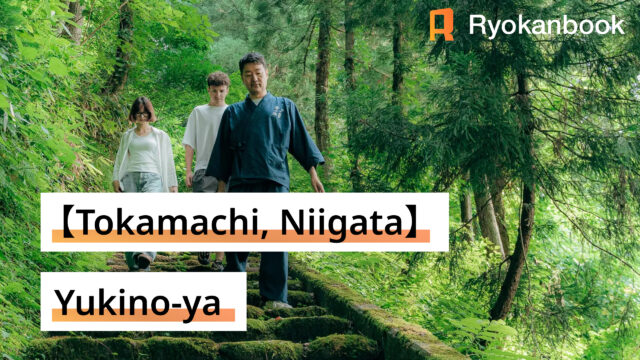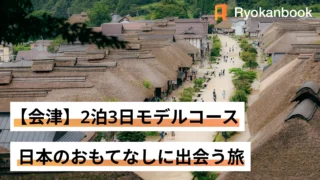
Tokamachi City, Niigata Prefecture—one of Japan’s heaviest snowfall regions.We visited the hidden retreat ‘Kamosu Mori,’ nestled within its lush forests. This place is truly a “restaurant where you can stay,” offering an authentic pairing course that combines Niigata’s finest local sake with seasonal ingredients.
In this article, we introduce the charm of Kamosu Mori that became apparent through our visit, along with recommended courses you should definitely experience when visiting Matsunoyama.
Author Profile (顔写真+吹き出し)
Hello, I’m Aoi, working at a travel agency.
Among the many places I’ve visited across Japan, one region I wholeheartedly recommend is Matsunoyama in Niigata. I’ll share with you the charm of this place, where rich nature and the warmth of its people thrive.
▷View more details about Kamosu-mori
- Niigata: Land of Rice and Sake
- “Kamosu Mori”|Theme: “Fermenting You”
- Annex | A Private Villa Embraced by the Forest
- Kamosu Mori Summary | A Stay That Lets You Savor Niigata with All Five Senses
- Day Two|A Journey to Encounter Nature and Art in Matsunoyama
- 1. Bijinbayashi — A Special Walk with a Local Guide
- ■ The Hidden Gem Guided Tour: “Heart-Beautiful Hiking”
- ② Ōmuneyama Art Museum ― A Small Intellectual Adventure Through Time
- ■ The famous spring water “Yanagishimizu” you can still drink today
- ■ The Building Itself Tells the Story
- ■ Exhibits: “Fragments of Life and Culture”
- ③ Echigo-Tsumari Art Field — A “Gateway to Satoyama Art” Surrounded by Water
- Summary|Tokamachi Area: A Town Cherished for Art and Hot Springs
Niigata: Land of Rice and Sake
Out of the blue, but what’s your favorite Japanese food?
For me, it’s definitely “rice.”
I’ve tried all kinds of rice from across Japan, but the one I’ll never forget is rice from Niigata, the snow country.Known as one of Japan’s heaviest snowfall areas, Niigata is truly a rice-growing region.
The snow that piles up in winter acts like a “natural refrigerator.” Come spring, it melts slowly into pure, clear meltwater. This water nourishes the rice paddies, cultivating rice with just the right amount of stickiness and sweetness.
And where the rice is delicious, there is delicious sake.
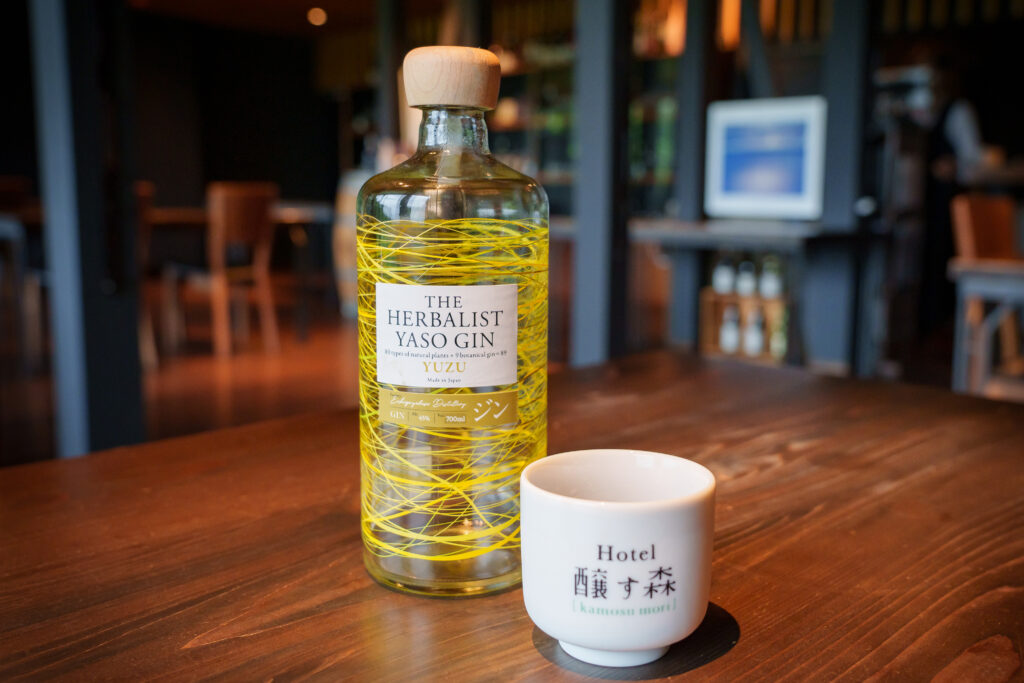
▶︎What is Japanese Sake?
Japanese sake is a traditional Japanese alcoholic beverage made by fermenting rice and water.
Its flavor varies by region and climate, allowing you to enjoy the unique character of each locality.
Niigata boasts an impressive 89 sake breweries—the highest number in the entire country. Delicious rice, clear snowmelt water, and a cold climate.
It’s precisely because all these elements come together that Niigata is called “Japan’s premier sake-producing region.”
This time, we introduce ‘Kamosu Mori’—a lodging where you can enjoy such delicious sake alongside pairing dishes.
It’s a place I confidently recommend: offering new discoveries for first-time sake tasters and expanding the flavor horizons for sake enthusiasts alike.
“Kamosu Mori”|Theme: “Fermenting You”
Let’s start by looking at the origin of this inn’s name.
The word “kamosu” originally means “to brew or ferment over time.”
In Matsunoyama, people have long been brewing miso and sake by hand, and that tradition continues today — miso is still being prepared in the inn’s basement, while craft sake is brewed at the neighboring sake brewery.
The concept behind the name, “to brew you,” was born from this local way of life. It reflects the hope that a stay here will be a time for your heart and senses to slowly mature and deepen — just like fermentation itself. Isn’t that a beautiful idea?
Many Japanese inns carry the heartfelt thoughts and stories of their owners.
When you travel, try paying attention to those meanings — they often reveal something special about the place.
An Inn Run by a True “Professional of the Sake World”

The concept of Kamosu Mori was born from the vision of its owner, Yūichi Yamagishi.The moment I first met him at the entrance, I remember thinking instinctively, “He’s as pure as natural spring water.” His clear, crystal-like eyes and gentle voice—soft like the sound of a harp—left a strong impression on me. When I later learned that he was born and raised here in the beautiful natural surroundings of Matsunoyama, it all made perfect sense.
Despite his calm and serene demeanor, Mr. Yamagishi is actually a true professional in the world of alcohol, holding certifications as both a wine sommelier and a sake sommelier (kikizakeshi).In our interview, he shared stories about the inn’s early days and his vision for its future. I’d like to share a few excerpts from that inspiring conversation with you.
Aoi:
When did Kamosu Mori first begin?
Mr. Yamagishi:
We opened about eight years ago, in the summer of 2018.
From the very start, I wanted to take on challenges that no one in Niigata had yet attempted — to step into areas that even sake breweries had never explored, and to expand the possibilities of Japanese sake.
Aoi:
That’s wonderful. By the way, what kind of characteristics does Niigata sake have?
Mr. Yamagishi:
Well, for a long time, Niigata’s sake has been known for its tanrei karakuchi style — clean, crisp, and dry. But recently, the range has broadened dramatically, with more complex varieties that feature richness and acidity, as well as craft sake with unique expressions.
Aoi:
So Japanese sake is becoming more diverse, then.
Mr. Yamagishi:
Exactly.
My goal is to create sake that surprises people who aren’t familiar with it — something that makes them say, “I didn’t know sake could taste this good!” — while also intriguing seasoned drinkers with flavors they’ve never encountered before.
Through the pairing of sake and cuisine, I hope guests will experience firsthand how profoundly a good drink can transform their world.
Traveling across Japan to interview culinary experts, sake connoisseurs, and hospitality masters,I’ve come to realize that those who have mastered their craft possess an entirely different level of clarity about their world. Their core purpose—what they want to do and the world they wish to convey—never wavers. The services crafted by such individuals embody a “luxury of experience” that money simply cannot measure.
The greatest appeal|Niigata’s “one-of-a-kind” pairing
Nestled in the forests of Matsunoyama, Kamosu Mori is an auberge where nature, local culture, cuisine, and even the people who visit seem to “brew together” in perfect harmony—just as its name suggests.
The dishes are crafted by a chef who trained in Hokkaido and Tokyo, combining the freshest ingredients from local farmers in Kurokura with carefully selected produce from across Niigata and beyond. Each course offers a modern expression of the wisdom and fermentation culture born in Japan’s snowy regions.
Every plate reflects the blessings of the land and the subtle shifts of the seasons—an authentic embodiment of local gastronomy.


Guests can choose between two pairing courses — wine or sake.
Among them, I personally recommend the sake pairing, where you can fully experience the unique harmony of flavors that can only be found here in Niigata.
Each course features a carefully curated selection of five to seven different sake varieties.
Some gently follow the dishes, enhancing their umami with subtle depth; others, bright with acidity, add dimension like wine. There are also creative infusions with herbs or tea leaves, and craft sake aged in barrels — each bringing a distinct layer of flavor to every dish. Every detail, from temperature to glassware, is meticulously considered, creating a truly sensory, luxurious experience.
“We always design the pairings after finalizing the dishes, so there’s no fixed combination,” says Yamagishi. “In fact, it changes every day — and that’s what makes it exciting.”
From his expression, you can clearly sense both his deep curiosity and quiet confidence in the art of pairing.

Kamosu Mori offers two distinctive charms that set it apart from typical pairing restaurants.
The first is its focus on locally sourced ingredients from within Niigata Prefecture, which take center stage in every dish.
The second is the unexpected yet delightful collaboration between Japanese ingredients and Italian cuisine, creating a dining experience full of surprise and harmony.
“Yairo Shiitake Stuffed with Salsiccia and Okra Salsa Verde”
~ A Dish That Captures the Essence of Minamiuonuma’s Land ~

There was one pairing dish that truly astonished me —
the Yairo Shiitake Stuffed with Salsiccia and Okra Salsa Verde.
The Yairo Shiitake used in this dish is a premium mushroom brand from Minamiuonuma, Niigata, nurtured by the region’s pure underground spring water. Many people find the unique aroma and texture of shiitake mushrooms challenging — I used to be one of them as a child. But this variety is in a class of its own.
It features a thick, meaty cap, a sturdy stem, a snow-white sheen, and delicate, radial gills. The texture is so plump and springy that it almost feels like abalone, with a gentle sweetness and none of the strong, earthy flavor typical of ordinary shiitake. It’s well known locally for converting even those who thought they didn’t like mushrooms.
Into this exquisite shiitake, the chef stuffs Italian salsiccia sausage and grills it to a beautifully fragrant finish — creating the dish, “Yairo Shiitake Stuffed with Salsiccia.”
What truly catches the eye, though, is the unexpected pairing of okra and cheese sauce.It’s an unconventional combination — one you’d rarely think to try in everyday cooking — yet it works beautifully. A touch of finely chopped walnuts adds a nutty aroma and a pleasant crunch, bringing balance and depth to the entire dish with remarkable finesse.
Annex | A Private Villa Embraced by the Forest

One experience you absolutely shouldn’t miss at Kamosu Mori is a stay at its private villa.
Opened in June 2023, this stand-alone villa sits deep within the forest, a short distance from the main building, and welcomes only one group per day — offering the ultimate sense of seclusion and serenity.
When you travel, you naturally want to experience something out of the ordinary. Here, time flows as if you’ve stepped into the pages of a storybook.
If I were to describe the atmosphere, it would be reminiscent of the Hundred Acre Wood from Disney’s Winnie the Pooh. Ever since childhood, I’ve longed to enter that gentle, dreamlike world — and during my stay here, it truly felt as though I had.
Surrounded by the rustle of trees and the songs of birds, you feel warmly welcomed by nature itself.
In the calm stillness, both mind and body gradually unwind.
It’s a place so special that I found myself thinking, “Next time, I want to come here with someone I love.”
1st Floor – Outdoor Living & BBQ Terrace
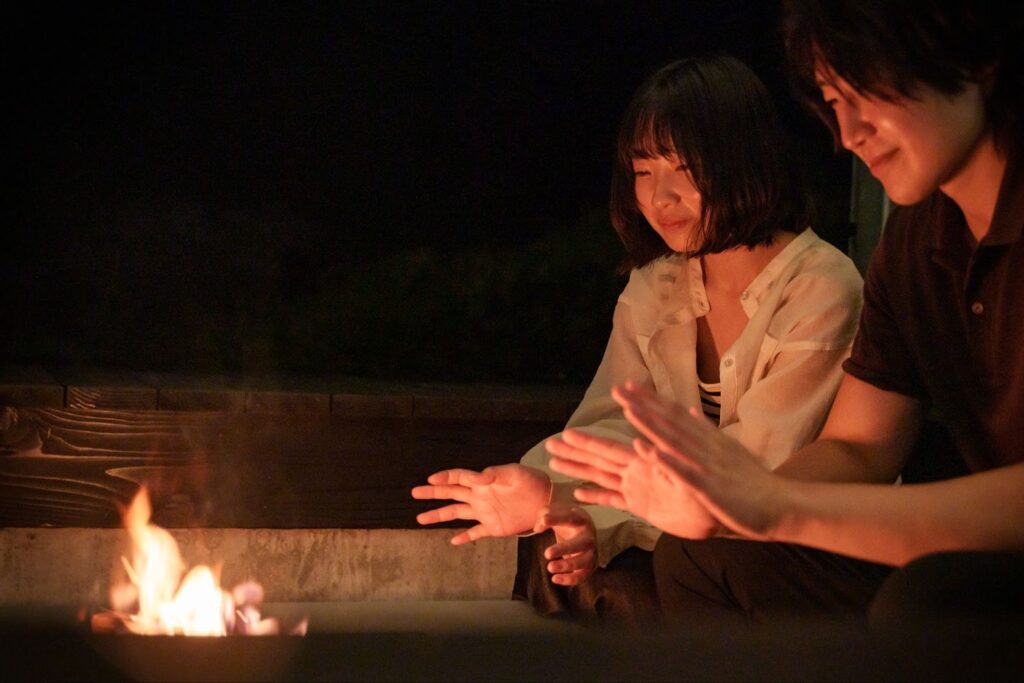
The first floor features a semi-open living area that feels seamlessly connected to the surrounding forest.
On the terrace, where chairs and tables are arranged beneath the trees, guests can gather around a firepit for relaxed conversation or bring their own ingredients to enjoy a casual BBQ — spending time however they wish.
As you sit enveloped by the warmth of the fire and the quiet of the woods, conversations flow naturally and hearts draw closer.
That sense of connection — both with nature and with one another — is what makes this terrace so special.
2nd Floor: A high-quality private space with a white color scheme
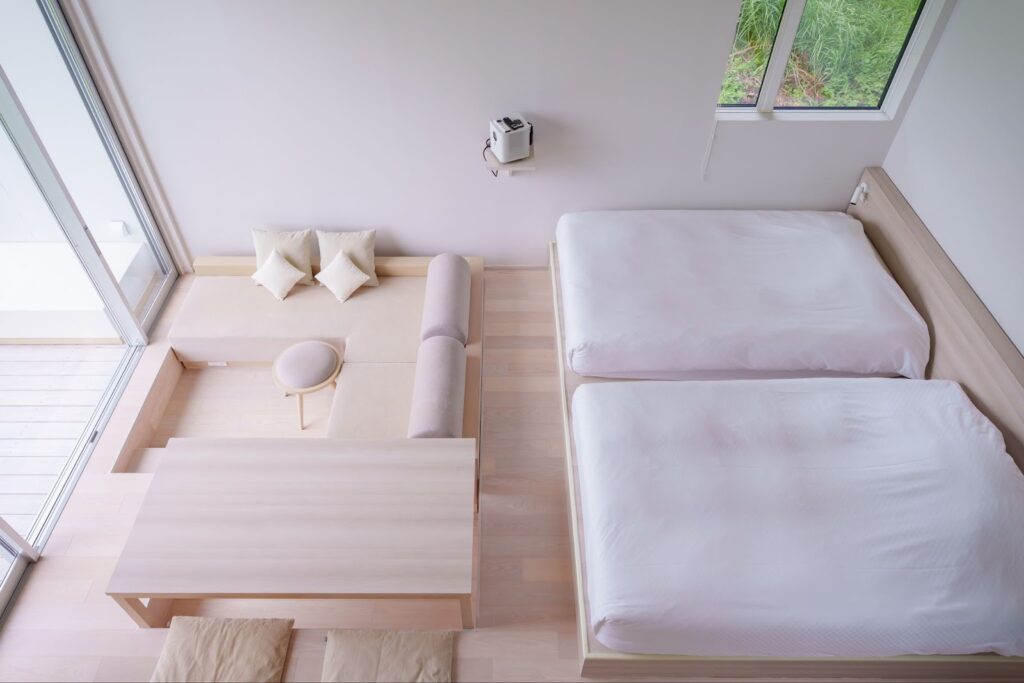
The moment you climb the stairs, the air shifts subtly. A quiet sense of excitement, as if invited into a villa suite.
The refined, white-toned interior features a spacious semi-double bed and a generously sized sofa, arranged with ample room. Not a trace of “lived-in feel” is visible anywhere.
【Niigata Exclusive】Free Drinks & Snacks

The first thing that surprised me upon entering the room was the impressive selection of complimentary drinks.Niigata-exclusive craft beers, Kamosu Mori original sake, and even juices were all chilled and lined up—the “help yourself anytime” approach felt like pure luxury! There’s nothing quite like enjoying drinks in a private space without worrying about others around you.
Among them, the unforgettable “Kamosu Mori Junmai Ginjo Nama-zake” stands out. The moment it touched my tongue, a sweet and sour flavor reminiscent of lychee and yogurt softly spread across my palate—like a dessert wine, but in sake form.
The shelves were also stocked with snacks like persimmon seeds and savory treats, making it easy to see why many guests inevitably start their evening drinks after bathing.
Fully equipped entertainment facilities
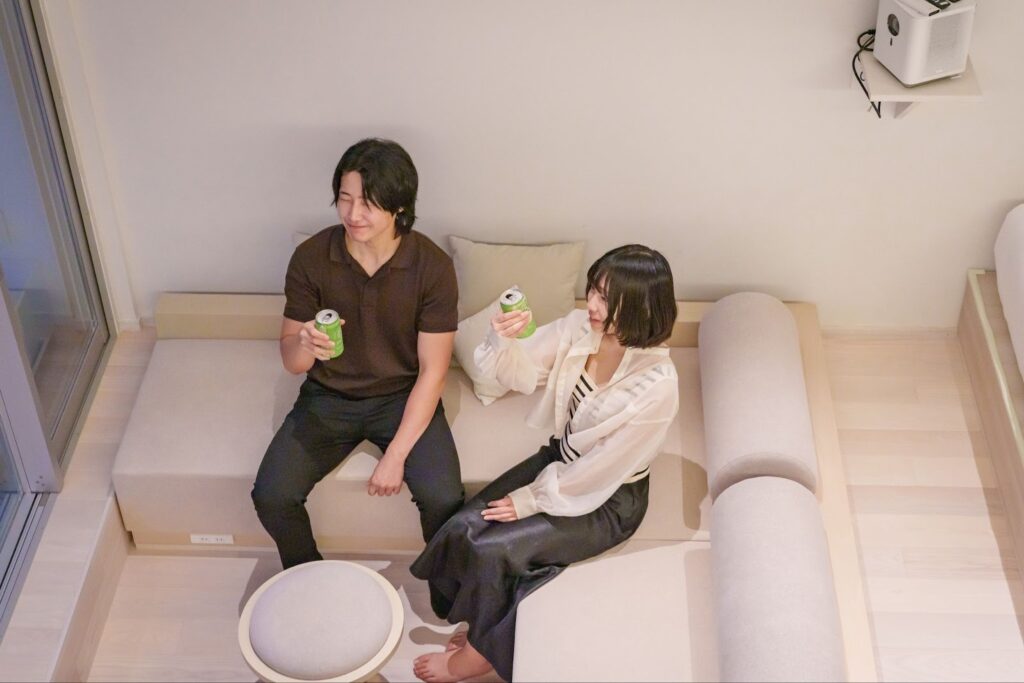
You can also lower the screen for movie viewing. A projector and Fire TV Stick are provided from the start, with Amazon Prime Video available for unlimited streaming. I could log into Netflix and TVer instantly using my own account.
It’s truly a space that perfectly fits the description of a “private theater in the forest.”
A cedar open-air bath overlooking the forest

Step out onto the veranda, and you’re greeted by an open-air bath where the scent of cedar gently rises. The moment you sink into the water, the soft fragrance drifting from the wood and the cool air sweeping through the forest caress your skin, seeming to calm even your breathing.
Nothing obstructs your view; only the sky and trees reflected on the water’s surface gently accompany you. A strange sense of immersion, as if you alone were floating within nature, slowly lets you forget the days spent chasing time.
Main Building Rooms|8 Distinct Rooms in the Main Building to Suit Your Preferences

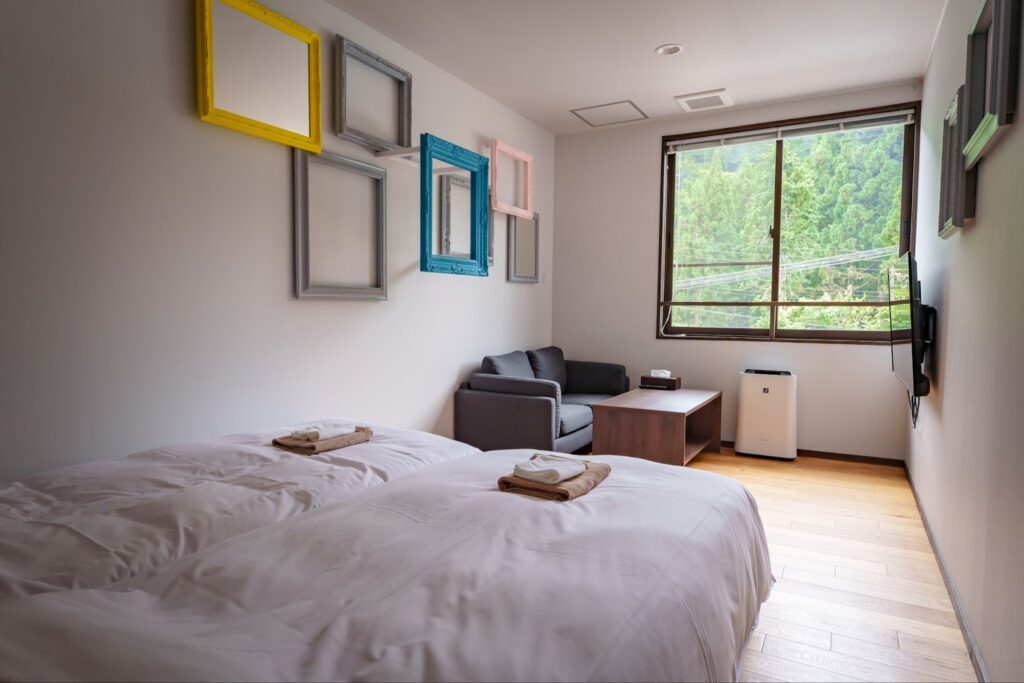
In addition to the private villas, the main building offers a total of 8 guest rooms. Their styles are remarkably diverse—from chic, tranquil rooms inspired by deep forests to compact modern rooms accented with art. The true appeal lies in choosing the perfect stay style to match your travel purpose and group size.
Public Bath | Immerse Yourself in “Jōmon no Yu”

The Source and Quality of the Hot Spring
The spring water of Jōmon no Yu wells up near the Jūmonji archaeological site, which dates back to the Jōmon period. The name itself carries a touch of mystery, and as you soak in the bath, you feel as though you’re being embraced by the ancient blessings of nature that have flowed since prehistoric times.
The water, gently streaming from the spout, is a hypotonic, mildly alkaline cold mineral spring. It is clear and colorless, with a faint hint of hydrogen sulfide when you draw close. The scent is subtle, almost unnoticeable at first — until you slip into the bath and feel its soft, silky texture envelop your skin.
The water blends so naturally with the body, leaving no stickiness, that it’s easy to understand why it’s often called a “beauty-enhancing bath.”
Facilities and Amenities
Inside the bathing area, you’ll find everything you need — shampoo, conditioner, body wash, and facial cleanser — along with a hair dryer. The changing and washroom areas are spotlessly clean, ensuring comfort even if you travel light.
Breakfast|A moment to nourish both mind and body
At Kamosu Mori, breakfast takes on a completely different tone from the refined dinner of the night before.
In the morning, you’re treated to a handmade Japanese-style set meal, lovingly prepared by local mothers who bring the warmth of home to each dish.
In fact, this breakfast is one of the main reasons I fell in love with this inn.
When I entered the dining room, the first thing that caught my eye was a handwritten menu, beautifully illustrated and full of personality.
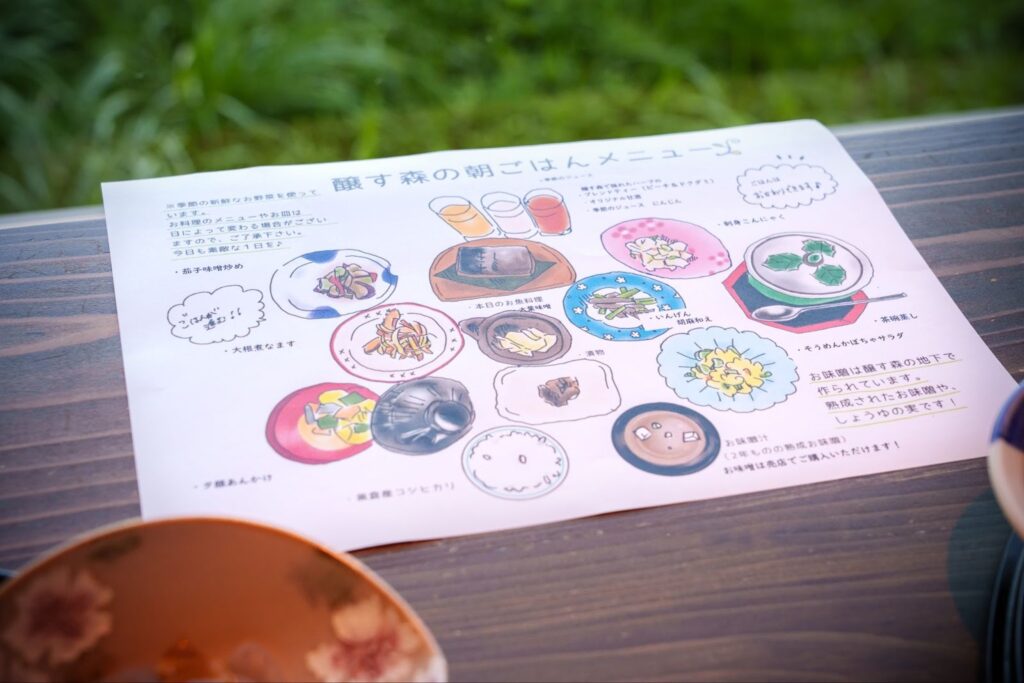
Mornings at traditional inns begin early. The mothers who prepare breakfast start working while it’s still dark outside — lighting the stove by 4 or 5 a.m., just as my own mother, who once ran a ryokan, used to do.
While travelers often think of dinner as the highlight of a stay, in a ryokan, breakfast is crafted with just as much care and devotion.
From that single sheet of paper — with its gentle handwriting and charming little drawings — you can feel their heartfelt wish:
“We want you to start your day in the best possible way.”

The breakfast that morning featured a beautiful selection of seasonal dishes made with the summer bounty of Matsunoyama, all prepared with care by the local mothers. Each item celebrated the freshness and flavor of local ingredients:
・Stir-fried Eggplant with Miso – made using their own house-fermented miso
・Grilled Salmon – a breakfast classic, simply seasoned to highlight its flavor
・Handmade Sashimi Konnyaku – a local specialty, kneaded and shaped by hand
・Simmered Daikon Radish with Vinegar – light and refreshing
・Perilla Leaf Miso – fragrant and slightly sweet, perfect with rice
・Green Beans Dressed with Sesame, Soy Sauce, and Sugar – a traditional side dish
・Winter Melon Soup with Thickened Broth (Yugao Ankake-wan) – a delicate, soothing dish
・Assorted Pickles (Three Kinds) – cucumber, turnip, and nozawana greens
・Spaghetti Squash Salad – a rare local ingredient that turns into noodle-like strands when shredded
・Steamed Egg Custard (Chawanmushi) with Thickened Sauce – silky and comforting
・Nameko Mushroom Miso Soup – featuring small, slippery mushrooms unique to Japan
・Kurokura-grown Koshihikari Rice – fragrant and perfectly cooked, from local paddies
・Three Homemade Drinks – a fragrant blended tea, house-made amazake (sweet fermented rice drink), and fresh carrot juice
With thirteen beautifully prepared dishes, the lineup felt almost too luxurious — I couldn’t help but feel excited even before taking my first bite.
Most of the flavors were built around miso made right here in Matsunoyama, a region deeply rooted in Japan’s fermentation culture.
Each dish carried the warmth and skill that only a true Japanese mother, seasoned by years in the kitchen, could create. Every bite was deeply comforting — a taste of home, filled with gentle nostalgia.
And then there was the freshly cooked Koshihikari rice from Kurokura, Minamiuonuma.
As I lifted the lid, the fragrant steam rose into the air, revealing glossy, perfectly cooked grains that glistened like jewels. With each bite, a natural sweetness spread across my palate.
While I savored the rice, one of the local mothers in the kitchen smiled and said,
“You can always have another bowl, you know.”
Kamosu Mori Summary | A Stay That Lets You Savor Niigata with All Five Senses
A stay at Kamosu Mori is a luxurious experience that gently soothes both body and mind through the five senses.
The sight of lush forest greenery and sunlit mountain ridges outside your window brings rest to the eyes, while the songs of birds and the whisper of the wind ease away the noise of everyday life.
Each meal, woven from Niigata’s seasonal ingredients and paired thoughtfully with fine sake or wine, is a revelation of flavor and craftsmanship.
In the morning, a colorful Japanese-style breakfast prepared by local mothers awaits — each small dish filled with warmth and care that nourishes not only the body but also the heart.
At the heart of this tranquil atmosphere is the inn’s owner, Mr. Yūichi Yamagishi.
His passion for “sharing the charm of Niigata with the world” is reflected in every detail — from his attentive hospitality to the artful pairing of food and drink.
Every moment at Kamosu Mori offers something that can only be experienced here:
a stay that awakens your senses, opens your heart, and leaves behind quiet joy and lasting inspiration.
Day Two|A Journey to Encounter Nature and Art in Matsunoyama

Matsunoyama in Niigata has long been cherished as a hot spring destination, but in recent years it has also quietly begun to establish itself as an “art town.”
Here, there is none of the hustle and bustle found in flashy tourist spots.
Yet, precisely because of this, certain things become visible.
The changing sounds of insects with the seasons, the scent of hot spring steam, quiet moments spent pausing before works of art.
These elements layered together made the entire town feel like a single work of art.
I believe this is where one finds a place that truly moves the heart.
1. Bijinbayashi — A Special Walk with a Local Guide

About a 10-minute drive from Kamosu Mori lies our first destination: Bijinbayashi, or “The Forest of Beauties.”
This beech forest spans roughly three hectares across the rolling hills of Matsunoyama, Niigata. The trees, each about a century old, rise straight and tall toward the sky — so graceful that locals began calling the grove “Bijinbayashi.”
What’s most surprising is that this forest wasn’t planted by human hands. At the end of the Taishō era, the trees were all cut down for charcoal, leaving the mountain bare. Yet the following spring, new buds sprouted on their own — a quiet miracle of regeneration.
Knowing that story before stepping into the woods changes everything. You’re not just visiting a scenic spot; you’re standing in a place that was reborn.
With every breeze, you hear the soft creak of trunks, the distant call of birds, and the earthy scent of moist soil unique to snow country. Within minutes, you’ll understand why locals say,
“This is a place to walk not with your voice, but with your breath.”
■ The Hidden Gem Guided Tour: “Heart-Beautiful Hiking”
I joined a guided tour called “Heart-Beautiful Hiking,” which you can casually hop on even mid-trip. Despite its laid-back vibe—sneakers are all you need—the experience turned out to be far more profound than I imagined.

Our guide was Mr. Oguchi from the Satoyama Blessings Guide Association. This small paid volunteer organization, formed by residents living in Matsunoyama, functions more like storytellers than tour guides.

As we walked, the stories our local guide shared were deeply woven into the landscape — connecting everyday life, geography, and history into one living tapestry.
Topics ranged from:
・how the once-barren forest was able to regenerate so fully,
・the wisdom of life in a region known for its heavy snowfall,
・the unspoken rules that allow birds, plants, and humans to coexist,
・and the satoyama philosophy of “not over-managing” nature.
With each story, I began to see the forest differently. It was no longer just a place I visited — I felt as if I had engaged with it, listened to it, and experienced it.
On the way back, my guide and I took a deep, slow breath together — a quiet moment of gratitude for the living world around us.
The view itself was unforgettable, but what stayed with me most was the air of the forest — calm, alive, and profoundly moving.
I found myself already wanting to return, perhaps in another season, to feel it all over again.
▷Learn more about Bijinbayashi
② Ōmuneyama Art Museum ― A Small Intellectual Adventure Through Time

A 6-minute drive from Bijin Forest.
This is the Ōmuneyama Art Museum, a place where the residence of the Murayama family—an old family that thrived for nearly 700 years—has been preserved as a museum. The history of this family, who prospered as village headmen and sake brewers, gradually unfolds the moment you step over the threshold.
■ The famous spring water “Yanagishimizu” you can still drink today
Beside the entrance, the “Yanagishimizu” spring flows steadily. This water was once used by the Murayama family for brewing sake. Hearing it’s still drinkable, I scooped it up with both hands and tasted it—it was astonishingly soft!
It felt unbelievably cold, like the midsummer heat was a lie, and tasted ten times better than any bottled mineral water from a vending machine.

The moment you step through the entrance, you sense an atmosphere slightly different from that of an ordinary museum. It’s a strange quietness, as if the building itself has become an exhibit.
■ The Building Itself Tells the Story
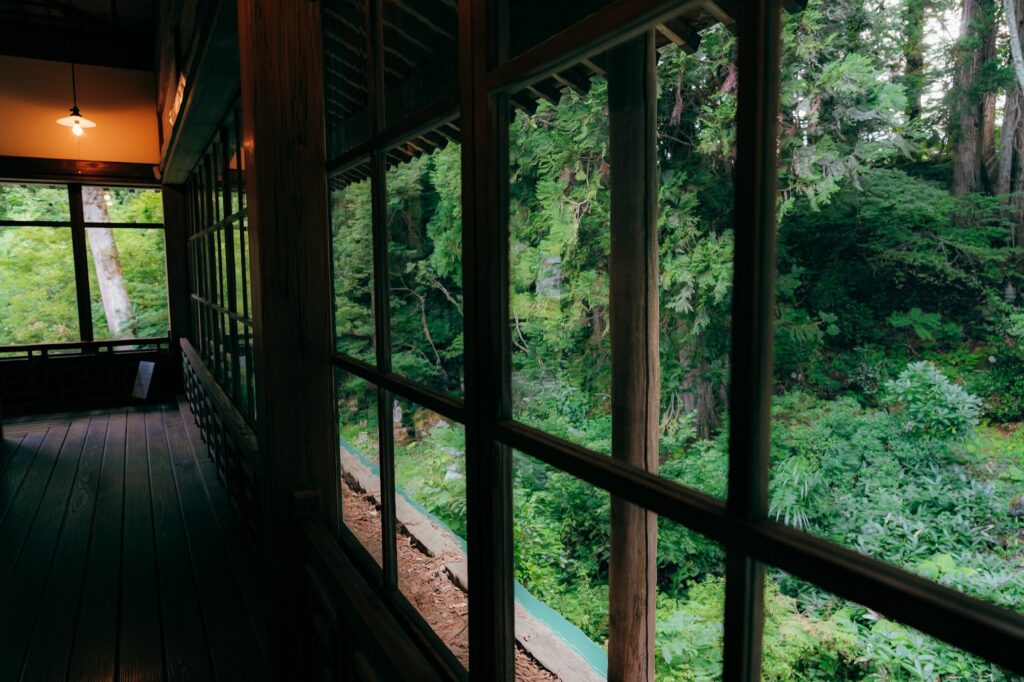
The moment I stepped inside, the main house took my breath away. Built after a fire in 1755, this structure has been preserved through careful restoration. Everywhere you look—the soaring ceilings, the zelkova wood corridors made from single planks, the study room, the box staircase—you feel the depth of craftsmanship and daily life from that era.
Its design, nurtured precisely because it stands in a heavy snowfall region, sets it apart from ordinary old houses. It felt like witnessing the very essence of modern Japanese architecture.
The use of a Korean-style gate in a private residence is rare, making its designation as a cultural property of Tokamachi City entirely understandable.
■ Exhibits: “Fragments of Life and Culture”

The museum displays more than just artworks. Here you’ll find household goods, ceramics, and calligraphy passed down through the Murayama family. The lifestyle of a wealthy farming family comes vividly to life before your eyes.
I heard many items were lost to fire and disaster, yet the surviving pieces carry the weight of time, carefully preserved by human hands. The antiques collected during the era of Masae and Shio seemed to radiate something beyond mere hobby—a sense of pride.
▷Learn more about tŌmuneyama Art Museum
③ Echigo-Tsumari Art Field — A “Gateway to Satoyama Art” Surrounded by Water
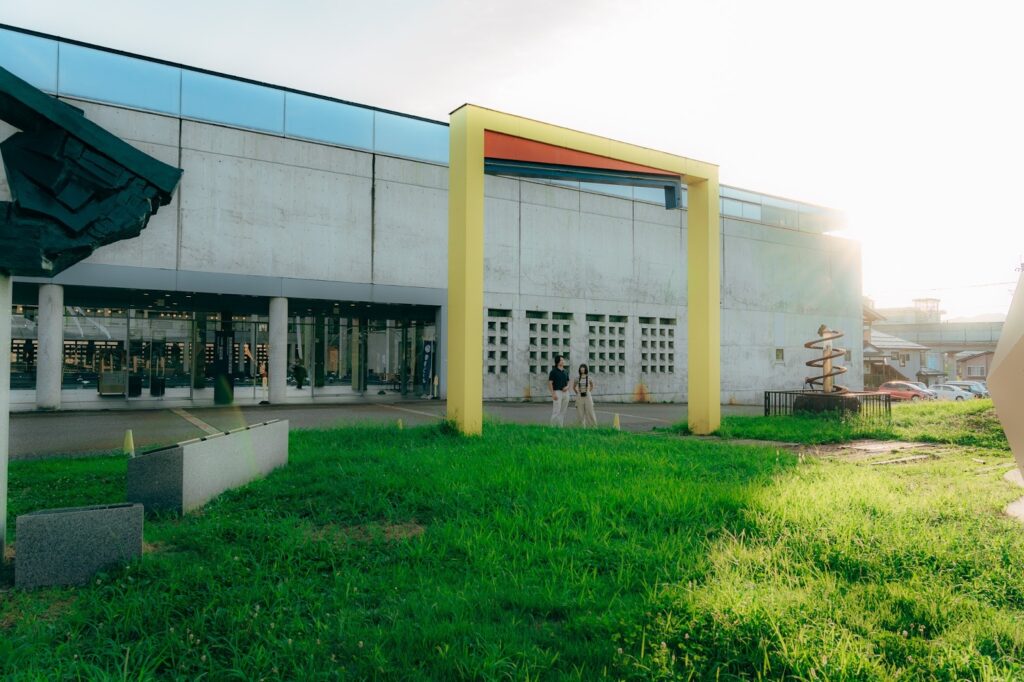
If you’re exploring art in the Matsunoyama area, a must-visit is Echigo-Tsumari Art Field, MonET.
Centered around a large reflecting pool, this museum was designed as a bridge between the region’s satoyama landscapes and contemporary art.
Originally opened in 2003 as Echigo-Tsumari Exchange Center Kinare, the building was transformed into a museum in 2012. Following a major renovation in 2021, it reopened as MonET — now a symbolic landmark of Echigo-Tsumari Art Triennale.

Stepping through the entrance, the first thing that catches your eye is the expansive pool of water at the heart of the building.
As the wind ripples across its surface, the reflections of the sky and architecture gently distort and shift — a mesmerizing scene that instantly calms the mind.

Each exhibition room is a self-contained structure, transforming the world around you with every step inside. Works that draw you beneath the floorboards, installations that flip your perspective upside down, spaces that plunge you into soundless darkness…
Exploring this museum while contemplating the artist’s intent feels like navigating an amusement park packed with thrilling rides.
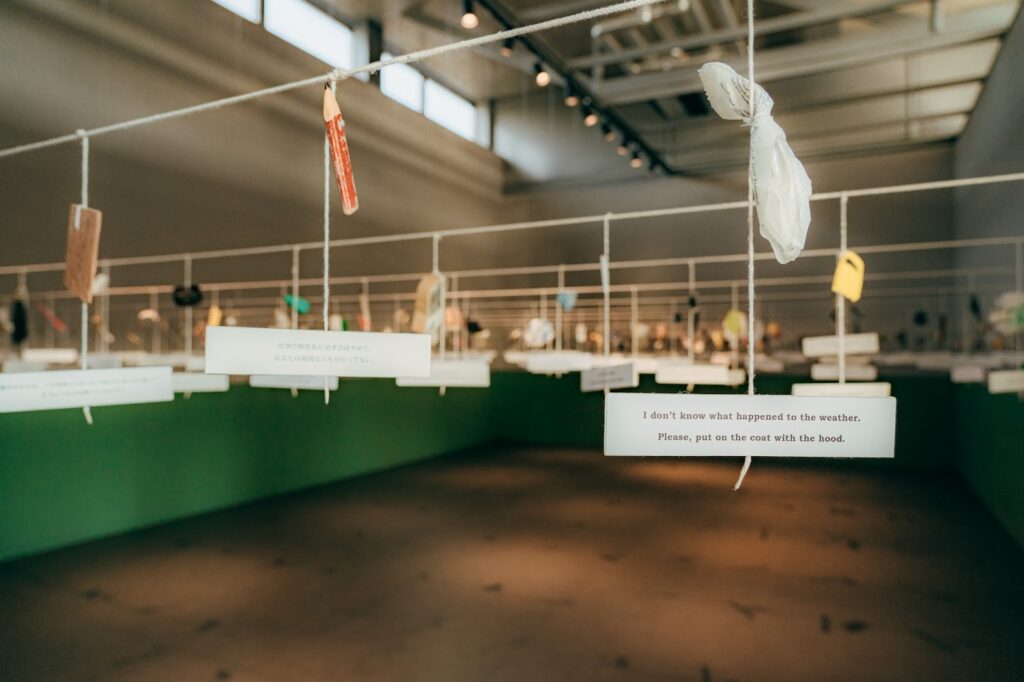
What left the deepest impression on me was a suspended installation hanging from the ceiling.
Countless strings descended from above, each holding a “forgotten object” — tissues, scraps of paper, socks — with a small handwritten message attached below.
One card, paired with a tissue, caught my eye. It read:
“I don’t know what happened to the weather.
Please, put on the coat with the hood.”
Literally, it says, “The weather has changed somehow. Please wear a coat with a hood.”
But who is speaking? The tissue itself? Or the memory of the person who once used it?
That ambiguity transforms these everyday remnants into vessels of emotion and time. They’re no longer just discarded items — they’ve been given new meaning through imagination.
It’s the kind of artwork that’s completed only through the viewer’s interpretation — a reminder of why art is so compelling precisely because it has no single answer.

After taking my time to enjoy the exhibits, I stopped by the museum shop.
The shelves were lined with a wide variety of items — from magazines available only in Niigata to goods inspired by the artworks on display. The selection was impressively curated and full of local character.
I couldn’t resist picking up a few souvenirs myself: some MonET-exclusive sweets and a book about Echigo-Tsumari Art Triennale.

And another charm of this museum:
Would you believe it has its own hot spring facility on the grounds? Soaking in the bath while still immersed in the afterglow of your viewing experience— this is the unique luxury of Matsunoyama, a place cherished by both art and hot springs.
After a long day of walking, please take your time to relax your body here.
▷Learn more about Echigo-Tsumari Art Field
Summary|Tokamachi Area: A Town Cherished for Art and Hot Springs
Travel varies in many styles.
Journeys to savor delicious food, journeys seeking breathtaking views, journeys to experience the extraordinary.
Among these, I felt the Tokamachi area is a place where you can experience a journey deeply connected to the land.
Walking through this region, you encounter art, architecture, hot springs, and the lives of its people.
In this area where nature and human endeavors have evolved side by side, small “beauties” breathe life into everyday life.
The people I met at inns, the handmade flavors, the satoyama landscapes.
Each left a gentle, deep resonance, as if time itself were slowly fermenting.
The charm of the Tokamachi area lies in its ability to offer a stay where you can step away from the hustle of daily life and blend into the local way of living.



